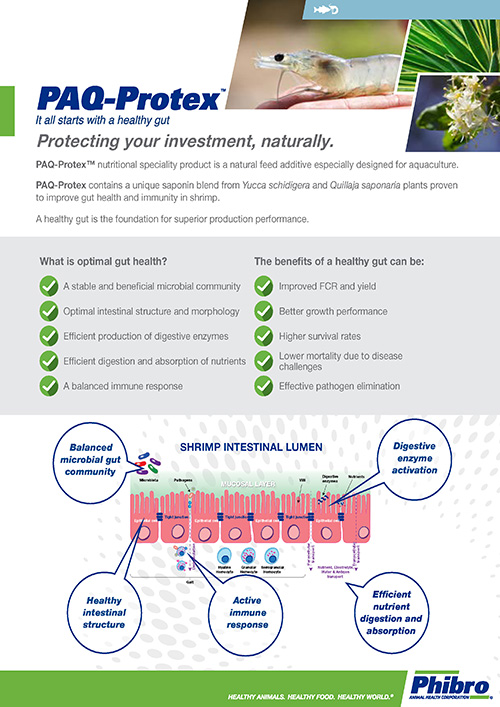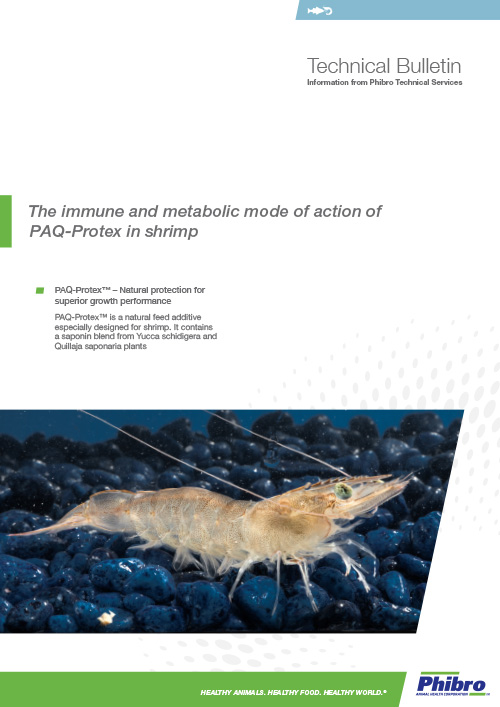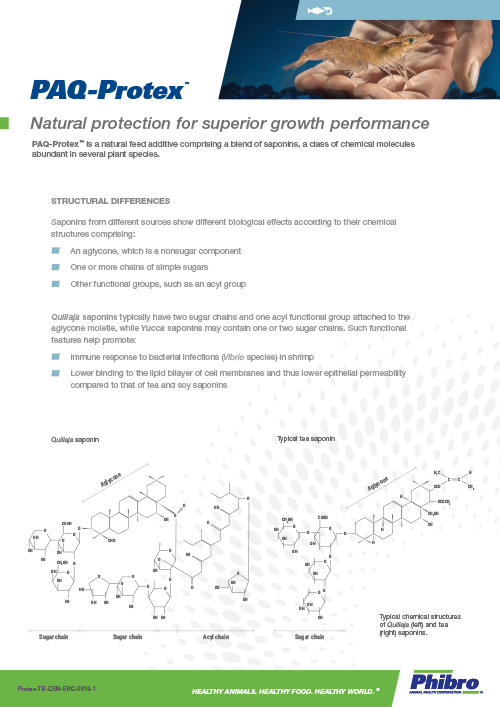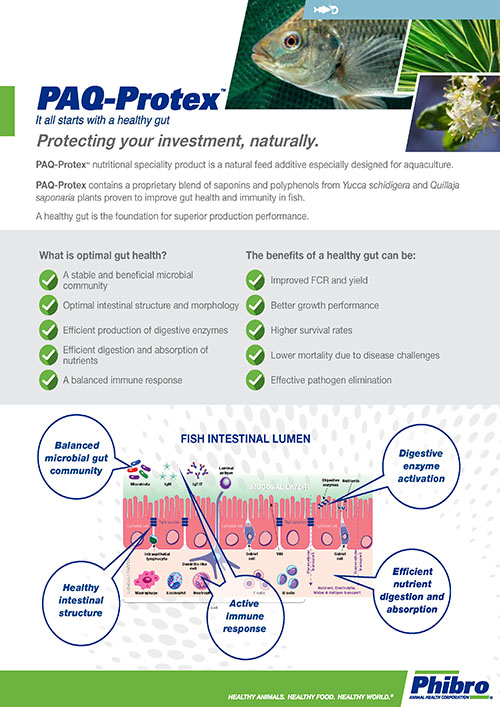
The key to optimising production yield and profitability in aquaculture is dependent on optimal gut health.
What is optimal
gut health?
 A stable and beneficial microbial community
A stable and beneficial microbial community Optimal intestinal structure and morphology
Optimal intestinal structure and morphology Efficient production of digestive enzymes
Efficient production of digestive enzymes Efficient digestion and absorption of nutrients
Efficient digestion and absorption of nutrients A balanced immune response
A balanced immune response
The benefits of a
healthy gut can be:
 Improved FCR and yield
Improved FCR and yield Better growth performance
Better growth performance Higher survival rates
Higher survival rates Lower mortality due to disease challenges
Lower mortality due to disease challenges Effective pathogen elimination
Effective pathogen elimination
PAQ-ProtexTM is scientifically proven to support gut health in shrimp and fish
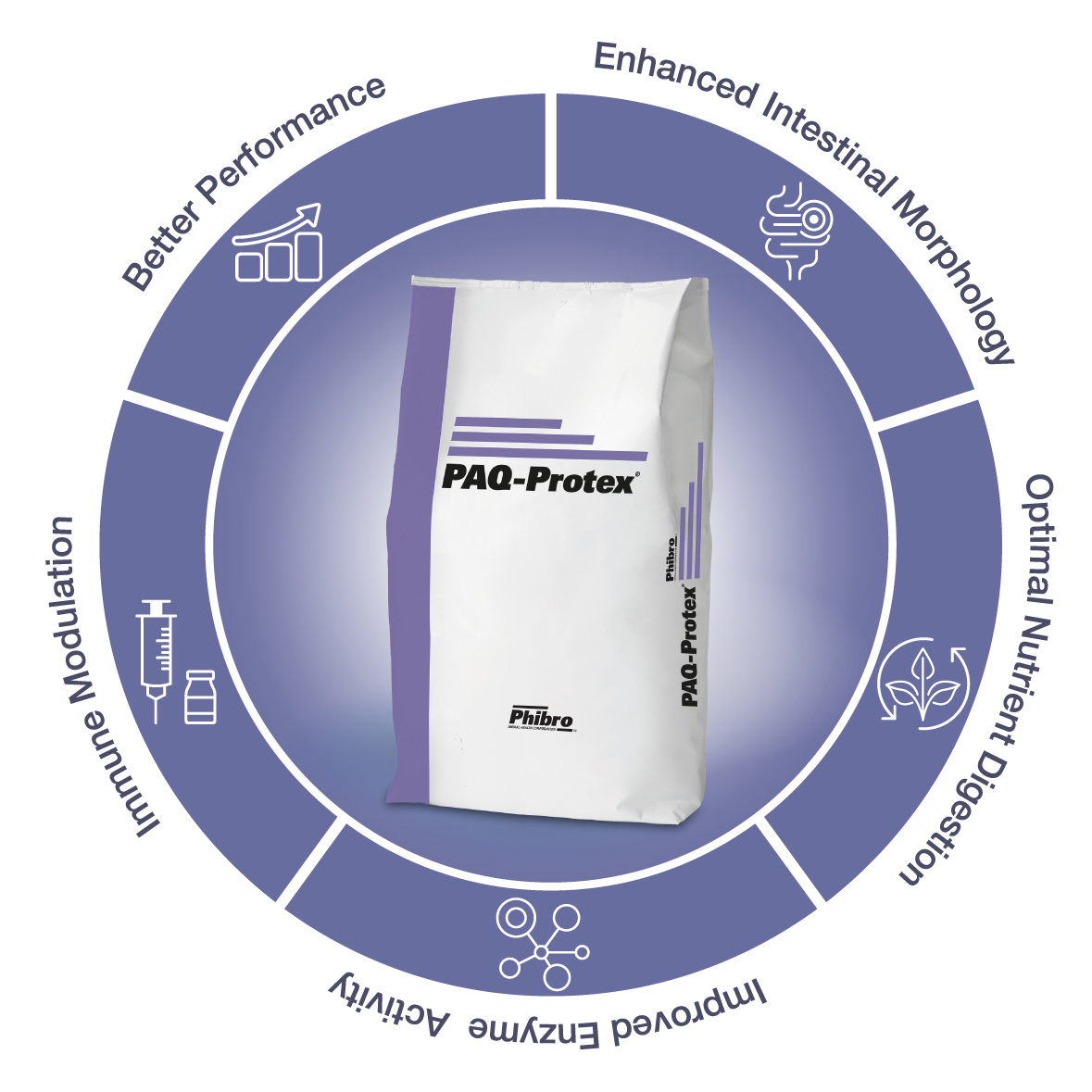
For shrimp and fish producers, PAQ-ProtexTM nutritional speciality product has consistently demonstrated improved gut health and immune response across all major aquaculture regions in the world.
 A 100% natural nutritional speciality product
A 100% natural nutritional speciality product Supports optimal gut health and immune function
Supports optimal gut health and immune function Increases feed efficiency and production yield
Increases feed efficiency and production yield

PAQ-Protex is sourced from specific species of Quillaja trees and Yucca plants, PAQ-Protex is a proprietary blend of triterpenoid and steroid saponins and polyphenols.
However, not all saponins are the same. Saponins from the Quillaja plant have been shown to produce meaningful changes in the digestive tract. Triterpenoid saponins and polyphenols in PAQ-Protex are known to improve intestinal health. They have immunomodulatory, anti-inflammatory and antioxidant properties and may help modulate the intestinal microflora, which leads to lower disease challenges and improved nutrient absorption. Quillaja saponins can increase gut cell permeability which leads to increased nutrient uptake while maintaining the barrier to pathogen entry.
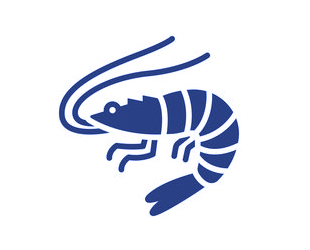
Shrimp Gut Health
How does PAQ-Protex support shrimp gut health?
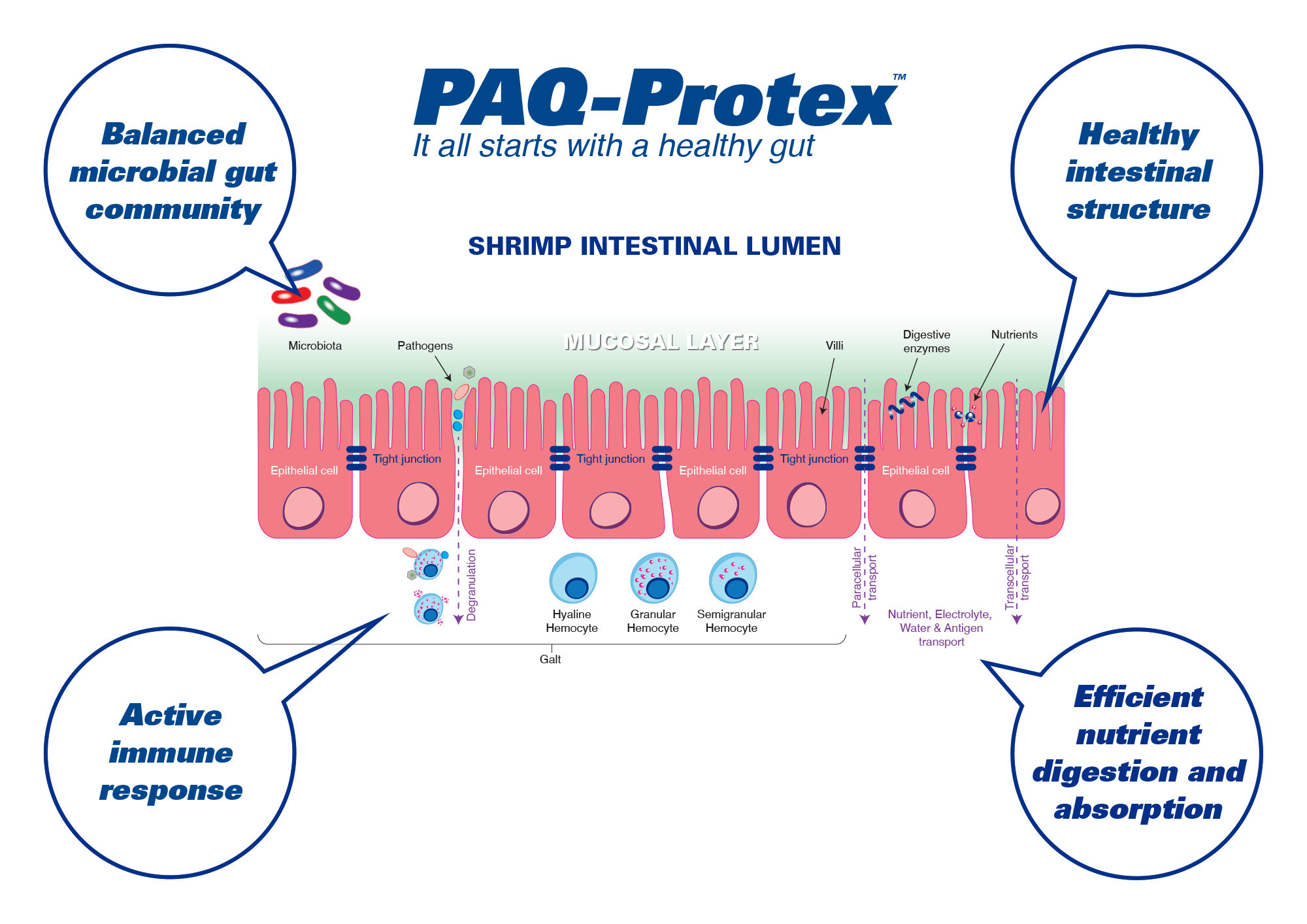
Click on each of the 5 elements to see how PAQ-Protex supports shrimp gut health

A study conducted in shrimp (Liptopenaeus vannamei) of 2g initial mean weight, in eight replicates of control groups not fed PAQ-Protex (A), and treatment groups fed 2kg/MT PAQ-Protex feed (B), showing enhanced intestinal structure of shrimp when fed PAQ-Protex (Phibro internal data).
Shrimp Not Fed PAQ-Protex - Grade 0 (low level to no intestinal folds):
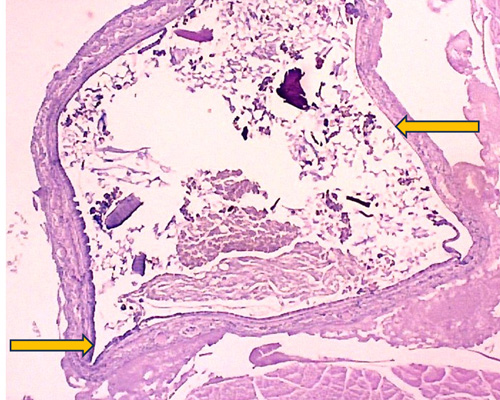
PAQ-Protex fed shrimp - Grade 4 (high level of intestinal folds):
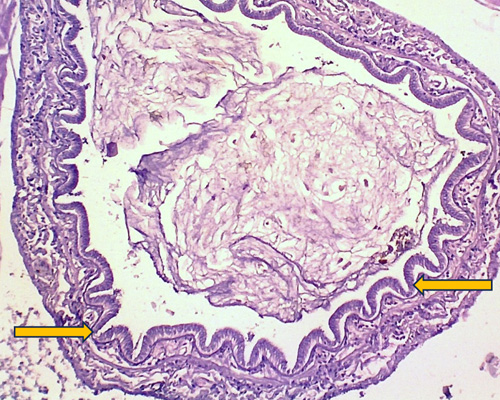

A study conducted in shrimp (Liptopenaeus vannamei) of 4g initial mean weight, in six replicates of control groups not fed PAQ-Protex, and treatment groups fed 2kg/MT PAQ-Protex feed, showing elevated levels of important immune cells of shrimp when fed PAQ-Protex (Phibro internal data).


A study conducted in shrimp (Liptopenaeus vannamei) of 2g initial mean weight, in six replicates of control groups not fed PAQ-Protex, and treatment groups fed 3kg/MT PAQ-Protex feed, showing reduced bacterial counts and improved survival of shrimp after infection with Vibrio parahemolyticus when fed PAQ-Protex (Phibro internal data).



A study conducted in shrimp (Liptopenaeus vannamei) with control groups not fed PAQ-Protex, and treatment groups fed 5kg/MT PAQ-Protex feed, showing reduced gregarines counts when fed PAQ-Protex (Phibro internal data).


A study conducted in shrimp (Liptopenaeus vannamei) of 2g initial mean weight, in four replicates of control groups not fed PAQ-Protex, and treatment groups fed 2kg/MT PAQ-Protex feed, showing increased digestive enzyme activity when fed PAQ-Protex (Phibro internal data).




A study conducted in shrimp (Liptopenaeus vannamei) of 4g initial mean weight, in six replicates of control groups not fed PAQ-Protex, and treatment groups fed 2kg/MT PAQ-Protex feed, showing elevated protein levels and protein retention when fed PAQ-Protex (Phibro internal data).




A Healthy Gut Leads to Superior Production Performance
A study conducted in shrimp (Liptopenaeus vannamei) of 2g initial mean weight, in 3 replicates of control groups not fed PAQ-Protex, and treatment groups fed 2kg/MT PAQ-Protex feed, showing a significant increase in weight gain when fed PAQ-Protex (Phibro internal data)


 (Phibro internal data)
(Phibro internal data)
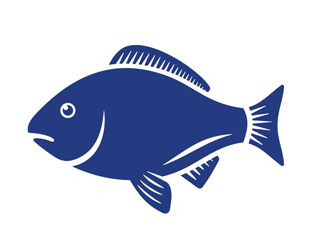
Fish Gut Health
How does PAQ-Protex support fish gut health?
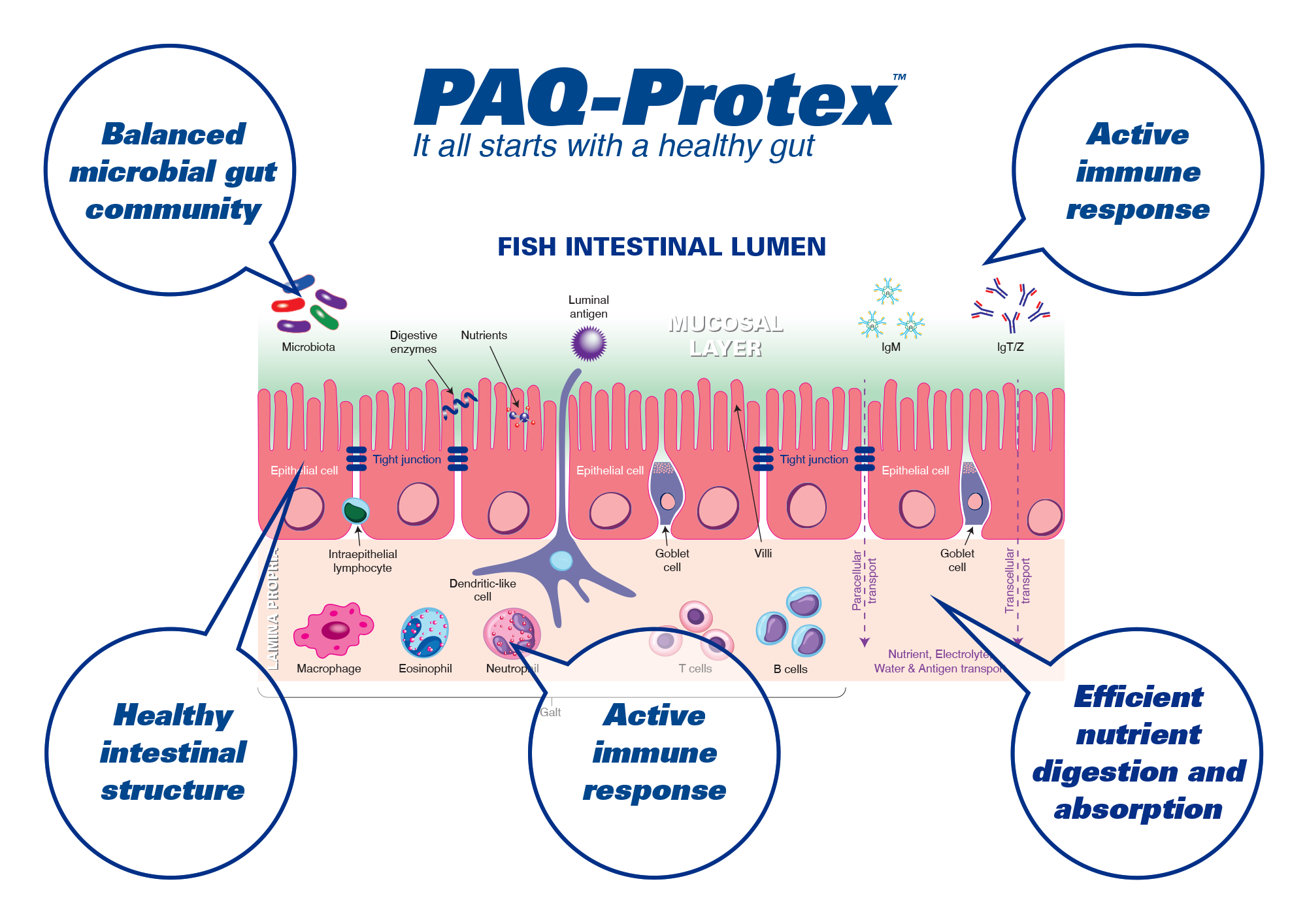
Click on each of the 5 elements to see how PAQ-Protex supports fish gut health

A study conducted in Red tilapia (Oreochromis sp.) of 10g initial mean weight, in six replicates of control groups not fed PAQ-Protex (A), and treatment groups fed 0.2kg/MT PAQ-Protex feed (B), showing increased size and density of villi in the middle intestine when fed PAQ-Protex (Phibro internal data).
Control (No PAQ-Protex)

PAQ-Protex (0.2kg/MT Feed)

A study conducted in Pangasius Catfish, in three replicates of control groups not fed PAQ-Protex, and treatment groups fed 0.25kg/MT and 0.5kg/MT PAQ-Protex feed, showing enhanced intestinal lumen villi numbers when fed PAQ-Protex (Phibro internal data).
37% more villi in the intestine when fed PAQ-Protex:


A study conducted in Red tilapia (Oreochromis sp.) of 10g initial mean weight, in six replicates of control groups not fed PAQ-Protex, and treatment groups fed 0.5kg/MT PAQ-Protex feed, showing increased levels of important immune cells when fed PAQ-Protex (Phibro internal data).

A study conducted in Red tilapia (Oreochromis sp.) of 10g initial mean weight, in six replicates of control groups not fed PAQ-Protex, and treatment groups fed 0.2kg/MT feed and 0.5kg/MT PAQ-Protex feed, showing up to 10% reduction in mortality after Streptococcus agalactiae infection when fed PAQ-Protex (Phibro internal data).

A study conducted in Nile tilapia (Oreochromis niloticus) of 79.6g initial mean weight, in five replicates of control groups not fed PAQ-Protex, and treatment groups fed 2kg/MT PAQ-Protex feed, showing improved survival after Francisella orientalis challenge when fed PAQ-Protex (Phibro internal data).

A study conducted in Pangasius Catfish, in three replicates of control groups not fed PAQ-Protex, and treatment groups fed 0.25kg/MT PAQ-Protex feed, showing reduced gut nematode counts when fed PAQ-Protex (Phibro internal data).


A study conducted in Sea bream (Sparus aurata) of approximately 22g mean weight, in four replicates of control groups not fed PAQ-Protex saponins, and treatment groups fed 2.0kg/MT PAQ-Protex feed saponins, showing increased amylase activity when fed PAQ-Protex saponins (Phibro internal data).


A study conducted in Nile tilapia (Oreochromis niloticus) of approximately 80g mean weight, in ten replicates of control groups not fed PAQ-Protex, and treatment groups fed 0.5kg/MT PAQ-Protex feed, showing increased digestibility of minerals when fed PAQ-Protex (Phibro internal data).

A study conducted in Nile tilapia (Oreochromis niloticus) and Common carp (Cyprinus carpio) showing elevated protein and lipid retention when fed PAQ-Protex saponins (Francis et al 2001).



A Healthy Gut Leads to Superior Production Performance
A study conducted in Red tilapia (Oreochromis sp.) of approximately 10g mean weight, in six replicates of control groups not fed PAQ-Protex, and treatment groups fed 0.2kg/MT and 0.5kg/MT PAQ-Protex feed, showing increased percentage weight gain when fed PAQ-Protex (Phibro internal data).


A study conducted in Hybrid tilapia (Oreochromis niloticus) of approximately 15g mean weight, in four replicates of control groups not fed PAQ-Protex, and treatment groups fed 1kg/MT PAQ-Protex feed, showing significantly increased total biomass when fed PAQ-Protex (Phibro internal data).

A study conducted in Pangasius Catfish in three replicates of control groups not fed PAQ-Protex, and treatment groups fed 0.25kg/MT and 0.5kg/MT PAQ-Protex feed, showing a dose-related improvement in Feed Conversion Ratio (FCR) when fed PAQ-Protex (Phibro internal data).

PAQ-Protex Research and Resources
See research trials and access helpful resources to support your aquaculture operation.
Phibro’s DQA® program is not just about testing ingredients. It is our promise to produce only the highest-quality products – from the sourcing of raw materials to our manufacturing process to industry-leading expertise and technical support. It is this commitment to excellence that helps us ensure our products are safe and effective for your animals.

Want To Know More?

PAQ-Protex nutritional speciality product contains a specialised proprietary blend of triterpenoid and steroidal saponins from Quillaja saponaria from Chile and Yucca schidigera. It is a natural solution that promotes the intestinal integrity of fish and shrimp, which helps improve defence against pathogens.

In simple terms, PAQ-Protex improves the digestive system of fish and shrimp to help fight off pathogens and leaves those cells to work on absorption of nutrients, which translates into an improved digestibility of protein, fats and minerals. Both compounds that make up PAQ-Protex have a specific action on the immune response of fish and shrimp. The Quillaja saponin works to stimulate the immune system which helps prevent pathogen attachment to the host and the Yucca saponin modulates the host’s innate and adaptive immune systems.

Quillaja and Yucca polyphenols in PAQ-Protex can help improve the immune response of fish and shrimp. An improved immune response can help alleviate non-specific inflammation and may improve leaky gut syndrome. Quillaja saponins can also help stimulate a specific, mostly cell-mediated, immune response to different pathogens, including bacteria, viruses or protozoa. Improved immune response can help improve intestinal morphometrics, absorption of nutrients, body weight gain and feed conversion ratio and may help reduce pathogen load.

- Gut epithelial cells act as a physical barrier, and a healthy gut is composed of epithelial cells that are tightly joined together (tight junctions). This allows for proper absorption of essential nutrients, while acting as a physical barrier to keep out unwanted agents such as invading pathogens.
- A healthy gut microbiome plays a crucial role in shrimp immunity by competing with pathogenic bacteria for space and nutrients, producing antimicrobial compounds, and modulating the immune system mainly by stimulating the production of antimicrobial peptides, enhancing phagocytosis, and regulating inflammatory responses.
- The gut-associated lymphoid tissue (GALT) contains immune cells, such as lymphocytes and macrophages, which are responsible for detecting and eliminating pathogens.
- The gut plays a multifaceted role in shrimp immunity, encompassing physical, microbial, and immunological aspects. Maintaining gut health through proper nutrition, environmental management, and disease prevention strategies is essential for promoting shrimp health and productivity.

- Gut epithelial cells act as a physical barrier, and a healthy gut is composed of epithelial cells that are tightly joined together (tight junctions). This allows for proper absorption of essential nutrients, while acting as a physical barrier to keep out unwanted agents such as invading pathogens.
- A healthy gut microbiome plays a crucial role in fish immunity by competing with pathogenic bacteria for space and nutrients, producing antimicrobial compounds, and modulating the immune system mainly by stimulating the production of antimicrobial peptides, enhancing phagocytosis, and regulating inflammatory responses.
- The gut-associated lymphoid tissue (GALT) contains innate and adaptive immune cells, such as lymphocytes and macrophages, responsible for detecting and eliminating pathogens, and B cells and T cells responsible for antibody production and eliminating infected cells.
- The gut plays a multifaceted role in fish immunity, encompassing physical, microbial, and immunological aspects. Maintaining gut health through proper nutrition, environmental management, and disease prevention strategies is essential for promoting fish health and productivity.

Quillaja saponins can integrate with their hydrophobic part (sapogenin) into the cell membrane and form complexes with cholesterol. In internal parasites such as gregarines and coccidia: which have high concentration of cholesterol on their cell membrane Quillaja saponins can form pores in the cell membrane or change the permeability of the pathogen and disrupt its’ biological function.
The Yuccaols and resveratrol in PAQ-Protex are excellent free radical scavangers and potent anti-inflammatory and antioxidant agents.
In shrimp, Quillaja saponins activate lysosome activation, initiating an immune cascade relevant to fighting Vibrio spp infections. PAQ-Protex can mitigate the ability of Vibrio parahemalyticus from ‘switching off’ lysosyme activity by triggering lysosomal activity when penetrating the epithelial cells. Quillaja saponins can bind to proteins and receptors presented in the cell and block pathogens from infecting them.
When Quillaja saponins enter the cells of fish, a series of adaptive and innate immune pathways are activated, giving a balanced immune response to fight invading pathogens.
Quillaja saponins can cause membrane folding which increases the gut cell permeability leading to increased nutrient uptake.

Our extensive research has shown that in fish, incorporation rates of between 0.25kg and 2kg of PAQ-Protex per MT feed is required to achieve the optimal performance and ROI.
In shrimp, incorporation rates of between 0.5kg and 2kg per MT feed have been shown to achieve the optimal performance and ROI.
To improve gut health and therefore production performance, PAQ-Protex should be given throughout the production cycle. Higher incorporation rates can be given to overcome persistent parasitic infestations.

We have not observed in research any harmful effects of PAQ-Protex on good bacteria in the gut. We continue to run microbiota analysis in an applied research setting to learn more.

Probiotics are live micro-organisms that, when provided in adequate amounts, can colonize the intestinal tract and produce metabolites. These metabolites can provide benefits to the host. Probiotics need specific conditions and nutrient substrates to affect the intestinal microbiome and produce the respective metabolites. PAQ-Protex nutritional speciality product is a phytogenic product containing Quillaja and Yucca saponins and polyphenols that help to modulate the host’s immune system. A well-balanced immune system can help reduce inflammation and stimulate a specific immune response to different pathogens.

Not all saponins are the same. Saponins from different sources have different biological effects. The saponins in PAQ-Protex are non-toxic to animals and the Quillaja saponins in PAQ-Protex contain both a lipophilic: and hydrophilic structure which gives them a unique immune mode of action. The Yucca schidigera saponins have a different, and complimentary, structure to Quillaja saponins so that when combined the result is a balanced pro-inflammatory and anti-inflammatory effect.
Talk to us
If you would like to know more about how PAQ-ProtexTM can support your aquaculture operation, get in touch:
email: info@phibro-aqua.com | web: www.phibro-aqua.com







